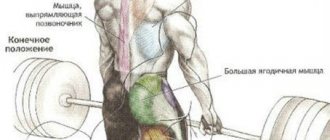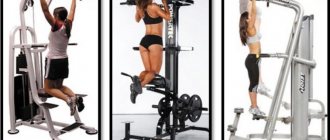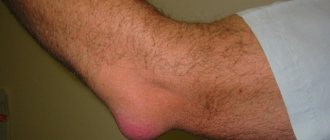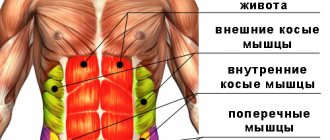Causes
Back muscle strains in most cases occur after strength training, as well as due to heavy lifting without prior preparation. A person can be injured by a fall, bruise or awkward movement. Weak muscle tone is one of the causes of back muscle strain.
To alleviate the patient’s condition, it is necessary to eliminate the main factor of disorders in the back area. The following reasons can cause sprains:
- long periods of work at the computer,
- excessive physical activity (more common in people who engage in strength sports),
- sudden lifting of weight,
- incorrect posture while walking or sitting,
- body twisting,
- driving for a long time,
- sudden movements.
Back problems can also appear after a stressful situation, hypothermia, or against the background of neurological disorders. It is important to seek help in a timely manner in order to prevent serious complications, the elimination of which will require a lot of time and effort.
Clinical symptoms
A low back sprain is a serious injury. The patient complains of severe pain and finds it difficult to move. In some situations, swelling forms at the site of injury. Diagnosis and treatment will depend on how correctly and accurately he described his condition to the doctor.
Main symptoms of a back strain:
- Severe aching dull or sharp pain in the lumbar spine. In some cases it radiates to the legs and buttocks.
- At the moment of complete relaxation, the patient feels better.
- The motor functions of the body are impaired.
- Pain syndrome manifests itself upon palpation of the damaged area.
- With moderate or severe stretching of the back muscles, swelling appears in the lumbar region.
If any sign appears, you must go to the hospital and undergo an examination to rule out rupture of the back muscles and fractures. Many people ignore the injury and continue to work, which can cause serious complications and consequences.
Dislocation of the lumbar spine or rupture of ligaments in this area is accompanied by swelling of the lower extremities. There is also severe pain that is present for a long time.
Such symptoms cannot be ignored; the patient requires qualified help.
Types of injuries and mechanism of injury
When pain occurs as a result of deadlift exercises, it can be caused by a number of traumatic changes in the body. Let's look at the easiest ones.
- A stretch, and doctors insist on the term rupture, of muscle fibers, provoking a muscle spasm that prevents the muscle from working normally.
- Ligament rupture, separation of some of the fibers, or complete rupture of the tissue connecting muscles and bones. The latter, more severe option, may be accompanied by the formation of hematomas.
- Displacement of the vertebrae - in the mild stage, is not accompanied by tissue damage and can be easily corrected if quickly detected. in severe cases, it can lead to pinched nerve processes and paralysis of the limbs. Frequent displacements lead to a high probability of their recurrence after the vertebrae (and discs) are put in place.
- Intervertebral hernia. At the beginning of its formation, a so-called protrusion (protrusion of the disc) occurs, in which destruction of the fibrous ring does not occur, but irritation occurs due to compression of the nerve roots. The second stage, prolapse, prolapse of the disc, with rupture of the outer shell, is the hernia itself.
- Vertebral fracture. More often this is a compression fracture caused by pressure and “sagging” of the intervertebral cartilage, which a person may not notice. But an untreated compression fracture can cause very serious complications in the future.
Sprains are usually caused by “incorrect” muscle work and insufficient recovery after training, which also causes wear and tear on the soft tissues of the spine. Depletion of spinal tissue and chronic overload are serious aggravating factors. Repeated overload makes the spinal tissue so vulnerable that even habitual stress can cause injury.
Diagnostics
If a person strains his lower back during training or after physical activity or exercise, he should go to the hospital. To make an accurate diagnosis, the doctor prescribes an additional examination, which includes:
- examination and collection of a primary medical history (a specialist checks reflex muscle contractions),
- X-ray of the back (attention is focused on the lumbar spine, the condition of the spinal column and processes is assessed),
- magnetic resonance imaging (MRI) and computed tomography (CT),
- Ultrasound examination of organs in the pelvic area (ultrasound).
A medical examination will determine the cause of pain and inflammation and will help eliminate damage to the integrity of bone tissue. Based on the results obtained, the doctor will establish an accurate diagnosis and select the most effective method of treating the pathology.
Answers to frequently asked questions
Question No. 1. Do you always need to treat your back if it’s broken, or can the pain go away on its own?
Painful sensations can indeed disappear on their own after a few days, especially if the back injury is caused by harmless reasons and is not accompanied by serious diseases of the spine. But with the slightest provoking factor, the pain will return, even intensify. Therefore, it is worth determining the cause, choosing the right treatment, and then going through a recovery period (massage, physical therapy, swimming) to strengthen the back muscle corset.
Question No. 2. What is better to use for back pain - ointments or tablets?
More often, doctors prescribe combination treatment, that is, a combination of tablet drugs (or injections) with local forms of drugs (ointments, gels). After the severe, piercing pain that is characteristic of a back injury has passed, only ointments can be used.
Question No. 3. Does lower back pain always indicate that your back is “broken”?
Pain syndrome is the main manifestation of the fact that a person has broken his back. However, lower back pain can accompany other diseases, not only of the spine and other structures of the musculoskeletal system, but also of the kidneys, genitals, urinary organs, etc. The reason can only be determined by a qualified specialist.
First aid
If a person feels pain in the back, it is recommended to immediately call a doctor or take him to the hospital. Before this, it is important to provide the victim with first aid correctly:
- Place the patient on a flat, hard surface to relax the muscles.
- Apply ice or a cold compress to reduce pain and inflammation that may affect nearby tissues. The procedures are carried out over 20-30 minutes.
- Give a pain reliever (“Ibuprofen”, “Aspirin”).
- Apply a cooling ointment (“Diclofenac”, “Finalgon”) to the site of injury. It will speed up the process of regeneration of damaged fibers.
On the first day after injury, the patient should avoid any physical activity and regularly apply cold compresses to the injured area. After the swelling subsides, you can use warming ointments (“Fastum gel”).
Therapy methods
Back strain is treated by a vertebrologist, traumatologist or surgeon. Therapy is carried out comprehensively and involves several stages. Cold should be applied on the first day. Heat will cause swelling and worsen the condition. If the vessels are damaged, bleeding will occur, leading to the formation of a hematoma.
Under the influence of heat, an inflammatory process or abscess will begin. The patient will require surgery, antibiotic therapy and a long hospital stay.
Traditional remedies
Complex therapy includes the following group of drugs:
- Anti-inflammatory drugs are used (“Diclofenac”, “Ortofen”, “Nimesulide”).
- Analgesics (“Lornoxicam”) are prescribed.
- Creams and ointments are used (“Menovazin”, “Troxevasin”).
- Muscle relaxants are prescribed to relieve muscle spasms (“Mydocalm”, “Baclofen”).
- Chondroprotective drugs are prescribed if, based on the results of the examination, the doctor has diagnosed a disease (osteochondrosis). The patient is prescribed “Alflutop”, “Teraflex”.
- B vitamins are used in tablets or injections. They help muscle fibers recover faster.
If a muscle tissue rupture occurs, the patient is indicated for surgical intervention. Back injuries can be dangerous and should not be self-medicated. A qualified specialist will determine the cause of the injury and tell you what to do if you have strained your lower back.
Exercise therapy
During therapy, patients are recommended to exercise and perform special gymnastics every day. It stretches muscles, speeds up the process of restoration of damaged ligaments, preventing ruptures.
Examples of effective exercises if you have strained your lower back:
- The patient lies with his back on a flat surface. Raises his leg, bends it at the knee and presses it to his stomach. Lowers the leg and repeats the exercise with the other limb. 10 approaches are enough.
- The patient lies on his back. Feet should be placed with your feet on the floor, knees bent. As you inhale, raise your back. Do not lift your shoulders and legs off the floor. As you exhale, lower your back. Perform the exercise for 3-4 minutes.
- The patient lies on his back. It is necessary to bend your knees and turn them in different directions. It is important to touch the floor as much as possible and stay in this position for 1 minute.
Physical exercise is recommended if there is no pain. Exercises are performed slowly and measuredly. If your condition worsens, you should stop exercising and consult a doctor.
Physiotherapy and manual therapy, massage
Back treatment involves not only the use of anti-inflammatory and painkillers. Complex therapy includes physiotherapeutic procedures and massage. In some situations, physiotherapy is contraindicated; only swimming and massage are allowed. This applies to patients with osteochondrosis, osteoporosis, arthrosis and cardiovascular diseases.
Physiotherapy includes visiting balneotherapy, medicinal electrophoresis, and magnetic therapy. After the procedures, metabolic processes in the damaged part of the spine are normalized and accelerated. The regeneration process is enhanced, and the mobility of the torso is restored faster.
You can use a special Kuznetsov applicator. Experts advise using an orthopedic mattress and pillow for sleeping.
It is also recommended to attend massage treatments to eliminate muscle tone and restore blood circulation in the damaged area. They will not only help ease muscle spasms, but also increase the production of endorphins (natural chemical compounds that reduce pain).
Prevention
Back strain can be prevented by remembering the helpful recommendations of specialists. Prevention allows you to strengthen the spine and muscle corset. More elastic muscles are less exposed to external risks and can withstand physical activity more steadily.
To avoid injury, just remember the following rules:
- If you have spinal diseases, you need to sleep on a hard surface and use low pillows.
- It is important to monitor your weight and prevent extra pounds. This is an additional load on the spinal column.
- In cold weather, wear a warming belt on the lower back.
- Experts recommend dancing, swimming and fitness. Exercises will help strengthen the muscle frame.
- Before physical activity or lifting weights, you need to warm up.
- You should avoid working with long bends; it is better to squat and keep your back straight.
- It is not recommended to lift objects that are too heavy without a supportive corset or belt.
- Avoid overcooling your back muscles.
It is important to monitor your health, lead an active lifestyle, exercise and follow simple advice from doctors. It is not recommended to lift heavy objects yourself. It is better to ask for help from relatives and friends to move them together. The load on the spine will not be as strong. You can also use a special orthopedic corset.
After treatment
When a positive medical result is obtained, pain and discomfort are removed, this does not mean that you can begin to carry heavy loads with the same enthusiasm. In order not to repeat mistakes and become a victim of a broken back again, you need to follow certain rules and not forget about prevention.
In order to no longer break your back, you need to approach the process of lifting and carrying weights competently. Parameters such as the angle of lift, its speed, body position, and the degree of muscle preparedness are important.
- You cannot lift a load while standing on straight legs and bending your back. First you need to half squat.
- You cannot take something heavy and only turn your torso; the whole body must turn.
- Before lifting weights, it is necessary to bring the muscles into a warm state.
How to lift objects correctly
After the attack is relieved and the functioning of the muscular system is normalized, the patient must reconsider his lifestyle. In the future, it is necessary to avoid repetitions of the painful situation and take actions to strengthen the spinal muscles.
You can regularly engage in any or several types of physical activity:
- exercises, including planking and strengthening the abdominal muscles;
- a set of exercises that improves posture;
- yoga;
- swimming.
A torn back always seriously disrupts the usual course of life. But if the phenomenon is ignored, has become habitual, is constantly removed with improvised means and not completely, then you can get chronic diseases of the spine, which can turn a person into a disabled person. That is why it is necessary to immediately seriously treat a torn back, bring the process to a complete result, and try to ensure that the situations that provoked this disease do not recur in the future.
Video – Broke your back at the dacha?! How to keep your back healthy
Choose among the best clinics based on reviews and the best price and make an appointment
Show all Moscow clinics
Show all Moscow specialists










